Financial Analysis and Acquisition Recommendation
VerifiedAdded on 2020/01/21
|10
|2858
|61
AI Summary
This assignment presents a comprehensive financial analysis of WPP PLC, focusing on its profitability, liquidity, and solvency using various ratio analysis techniques. The analysis also employs different valuation methods to determine the fair value of WPP's equity. Based on these findings, the assignment offers a recommendation to Barclay Bank concerning the acquisition of WPP PLC, taking into account factors such as profit margins, share prices, and overall financial health.
Contribute Materials
Your contribution can guide someone’s learning journey. Share your
documents today.
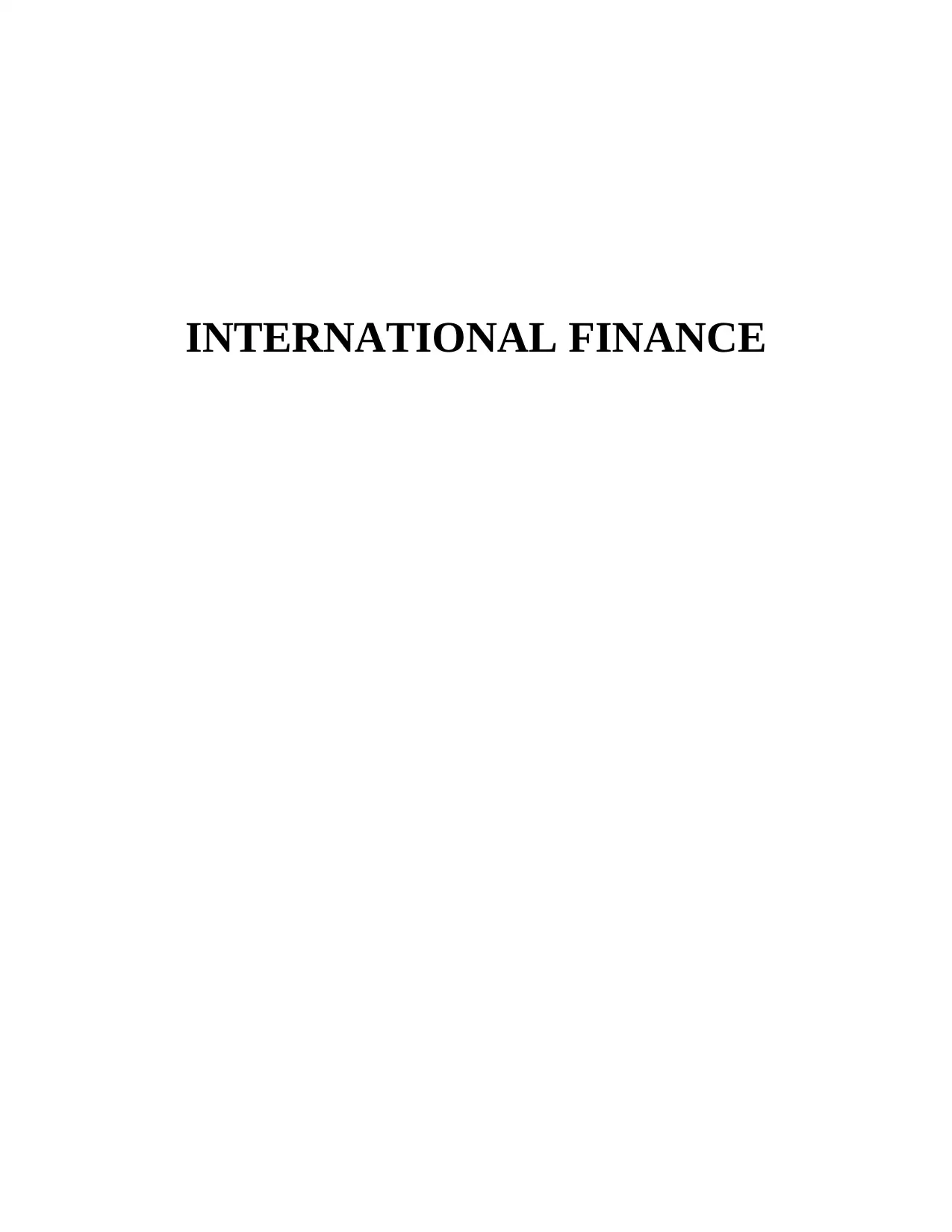
INTERNATIONAL FINANCE
Secure Best Marks with AI Grader
Need help grading? Try our AI Grader for instant feedback on your assignments.
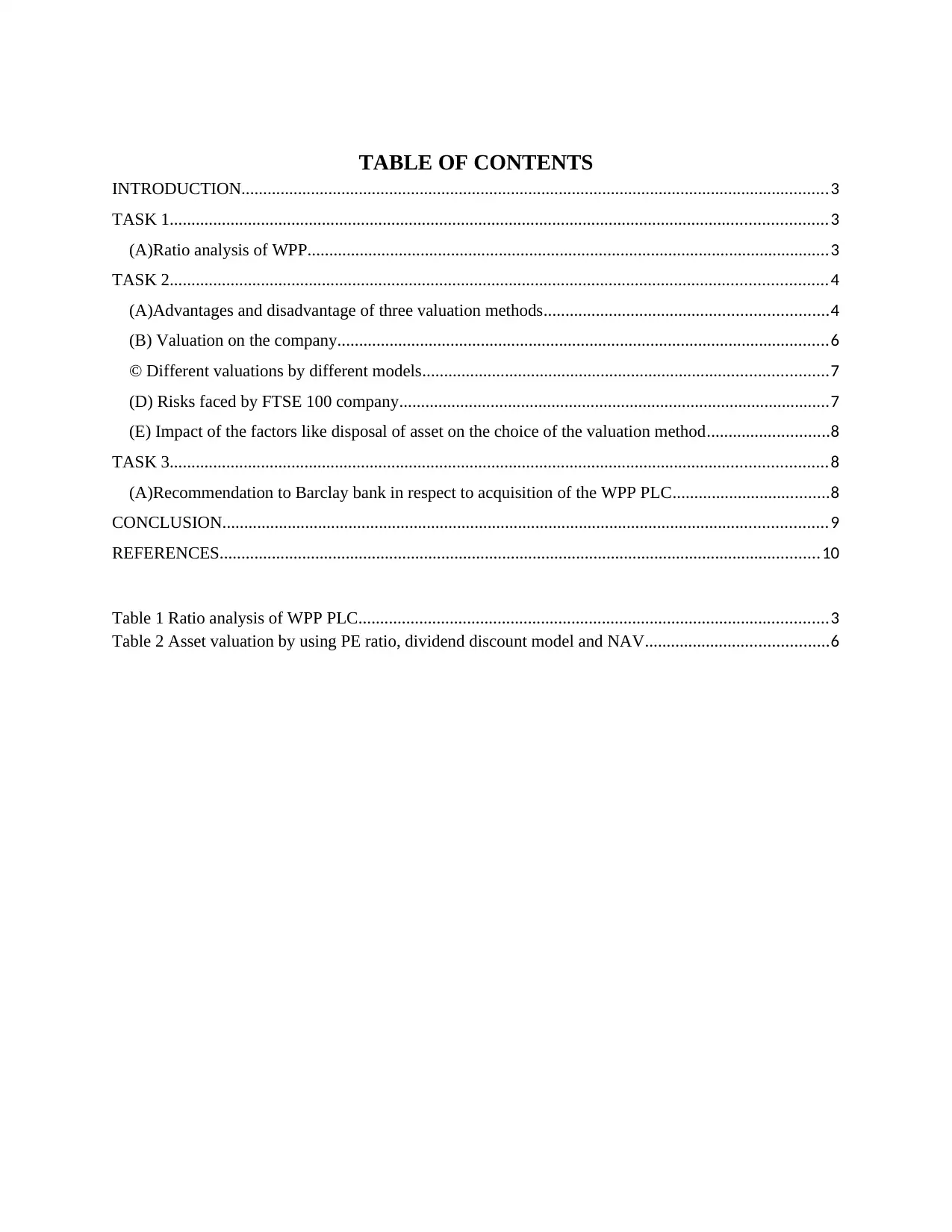
TABLE OF CONTENTS
INTRODUCTION.......................................................................................................................................3
TASK 1.......................................................................................................................................................3
(A)Ratio analysis of WPP........................................................................................................................3
TASK 2.......................................................................................................................................................4
(A)Advantages and disadvantage of three valuation methods.................................................................4
(B) Valuation on the company.................................................................................................................6
© Different valuations by different models.............................................................................................7
(D) Risks faced by FTSE 100 company...................................................................................................7
(E) Impact of the factors like disposal of asset on the choice of the valuation method............................8
TASK 3.......................................................................................................................................................8
(A)Recommendation to Barclay bank in respect to acquisition of the WPP PLC....................................8
CONCLUSION...........................................................................................................................................9
REFERENCES..........................................................................................................................................10
Table 1 Ratio analysis of WPP PLC............................................................................................................3
Table 2 Asset valuation by using PE ratio, dividend discount model and NAV..........................................6
INTRODUCTION.......................................................................................................................................3
TASK 1.......................................................................................................................................................3
(A)Ratio analysis of WPP........................................................................................................................3
TASK 2.......................................................................................................................................................4
(A)Advantages and disadvantage of three valuation methods.................................................................4
(B) Valuation on the company.................................................................................................................6
© Different valuations by different models.............................................................................................7
(D) Risks faced by FTSE 100 company...................................................................................................7
(E) Impact of the factors like disposal of asset on the choice of the valuation method............................8
TASK 3.......................................................................................................................................................8
(A)Recommendation to Barclay bank in respect to acquisition of the WPP PLC....................................8
CONCLUSION...........................................................................................................................................9
REFERENCES..........................................................................................................................................10
Table 1 Ratio analysis of WPP PLC............................................................................................................3
Table 2 Asset valuation by using PE ratio, dividend discount model and NAV..........................................6
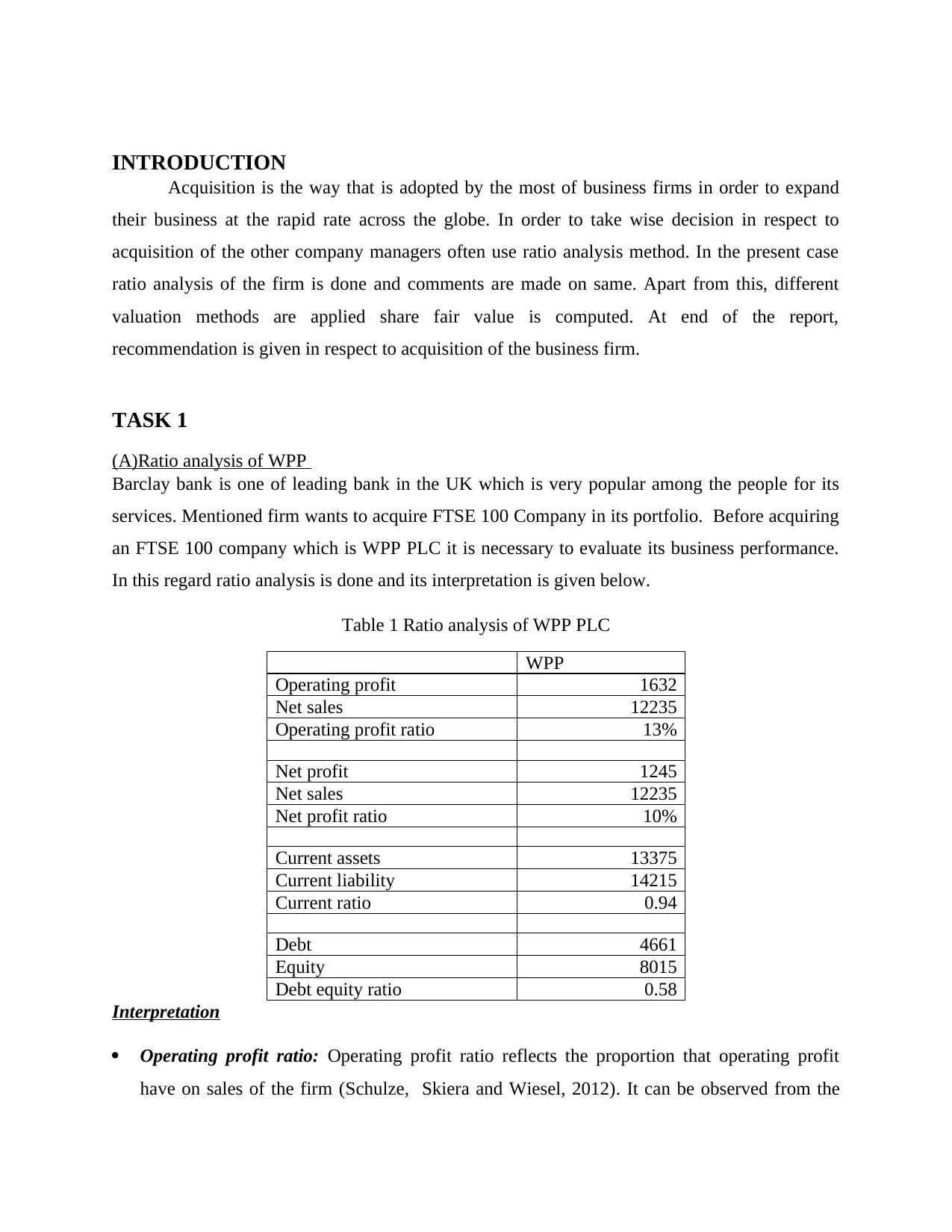
INTRODUCTION
Acquisition is the way that is adopted by the most of business firms in order to expand
their business at the rapid rate across the globe. In order to take wise decision in respect to
acquisition of the other company managers often use ratio analysis method. In the present case
ratio analysis of the firm is done and comments are made on same. Apart from this, different
valuation methods are applied share fair value is computed. At end of the report,
recommendation is given in respect to acquisition of the business firm.
TASK 1
(A)Ratio analysis of WPP
Barclay bank is one of leading bank in the UK which is very popular among the people for its
services. Mentioned firm wants to acquire FTSE 100 Company in its portfolio. Before acquiring
an FTSE 100 company which is WPP PLC it is necessary to evaluate its business performance.
In this regard ratio analysis is done and its interpretation is given below.
Table 1 Ratio analysis of WPP PLC
WPP
Operating profit 1632
Net sales 12235
Operating profit ratio 13%
Net profit 1245
Net sales 12235
Net profit ratio 10%
Current assets 13375
Current liability 14215
Current ratio 0.94
Debt 4661
Equity 8015
Debt equity ratio 0.58
Interpretation
Operating profit ratio: Operating profit ratio reflects the proportion that operating profit
have on sales of the firm (Schulze, Skiera and Wiesel, 2012). It can be observed from the
Acquisition is the way that is adopted by the most of business firms in order to expand
their business at the rapid rate across the globe. In order to take wise decision in respect to
acquisition of the other company managers often use ratio analysis method. In the present case
ratio analysis of the firm is done and comments are made on same. Apart from this, different
valuation methods are applied share fair value is computed. At end of the report,
recommendation is given in respect to acquisition of the business firm.
TASK 1
(A)Ratio analysis of WPP
Barclay bank is one of leading bank in the UK which is very popular among the people for its
services. Mentioned firm wants to acquire FTSE 100 Company in its portfolio. Before acquiring
an FTSE 100 company which is WPP PLC it is necessary to evaluate its business performance.
In this regard ratio analysis is done and its interpretation is given below.
Table 1 Ratio analysis of WPP PLC
WPP
Operating profit 1632
Net sales 12235
Operating profit ratio 13%
Net profit 1245
Net sales 12235
Net profit ratio 10%
Current assets 13375
Current liability 14215
Current ratio 0.94
Debt 4661
Equity 8015
Debt equity ratio 0.58
Interpretation
Operating profit ratio: Operating profit ratio reflects the proportion that operating profit
have on sales of the firm (Schulze, Skiera and Wiesel, 2012). It can be observed from the
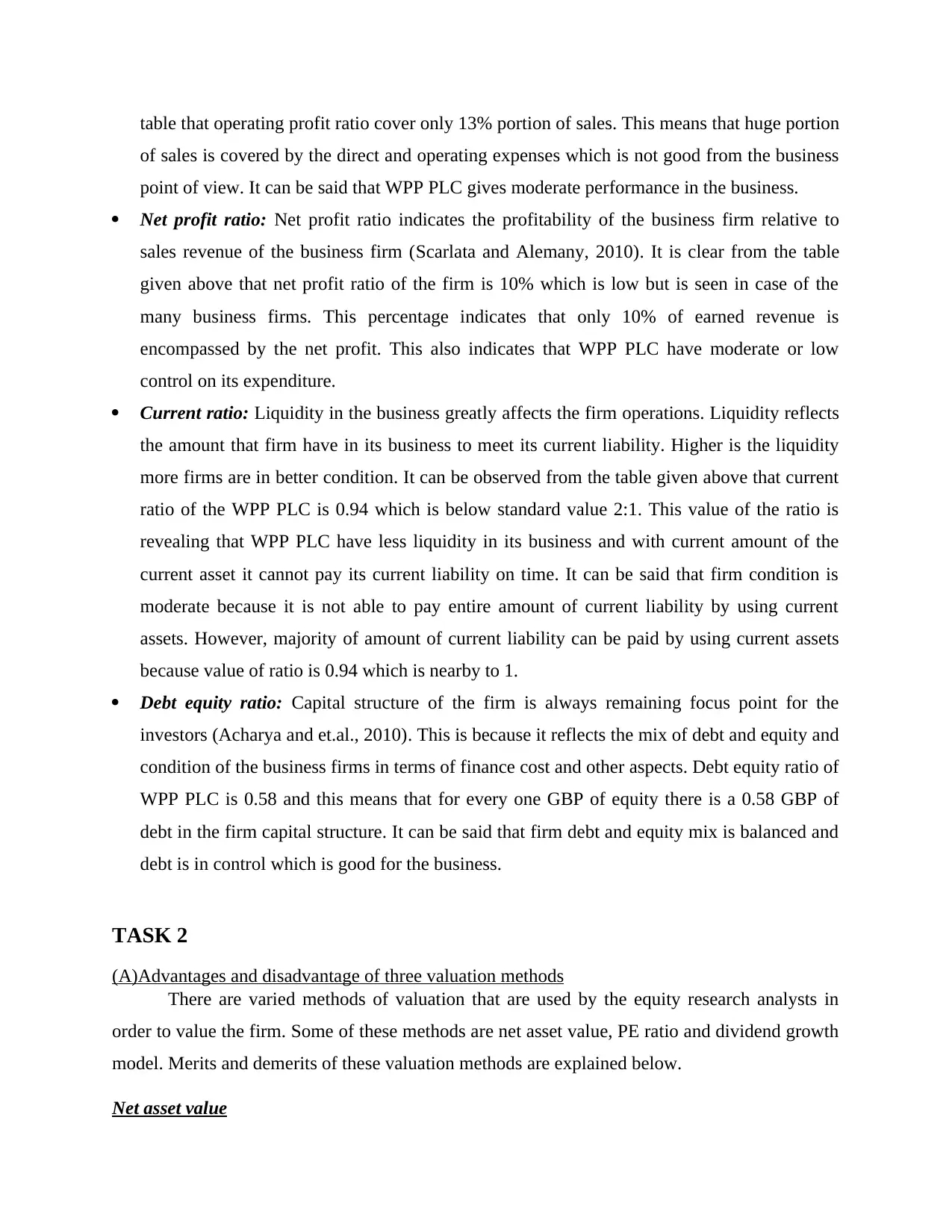
table that operating profit ratio cover only 13% portion of sales. This means that huge portion
of sales is covered by the direct and operating expenses which is not good from the business
point of view. It can be said that WPP PLC gives moderate performance in the business.
Net profit ratio: Net profit ratio indicates the profitability of the business firm relative to
sales revenue of the business firm (Scarlata and Alemany, 2010). It is clear from the table
given above that net profit ratio of the firm is 10% which is low but is seen in case of the
many business firms. This percentage indicates that only 10% of earned revenue is
encompassed by the net profit. This also indicates that WPP PLC have moderate or low
control on its expenditure.
Current ratio: Liquidity in the business greatly affects the firm operations. Liquidity reflects
the amount that firm have in its business to meet its current liability. Higher is the liquidity
more firms are in better condition. It can be observed from the table given above that current
ratio of the WPP PLC is 0.94 which is below standard value 2:1. This value of the ratio is
revealing that WPP PLC have less liquidity in its business and with current amount of the
current asset it cannot pay its current liability on time. It can be said that firm condition is
moderate because it is not able to pay entire amount of current liability by using current
assets. However, majority of amount of current liability can be paid by using current assets
because value of ratio is 0.94 which is nearby to 1.
Debt equity ratio: Capital structure of the firm is always remaining focus point for the
investors (Acharya and et.al., 2010). This is because it reflects the mix of debt and equity and
condition of the business firms in terms of finance cost and other aspects. Debt equity ratio of
WPP PLC is 0.58 and this means that for every one GBP of equity there is a 0.58 GBP of
debt in the firm capital structure. It can be said that firm debt and equity mix is balanced and
debt is in control which is good for the business.
TASK 2
(A)Advantages and disadvantage of three valuation methods
There are varied methods of valuation that are used by the equity research analysts in
order to value the firm. Some of these methods are net asset value, PE ratio and dividend growth
model. Merits and demerits of these valuation methods are explained below.
Net asset value
of sales is covered by the direct and operating expenses which is not good from the business
point of view. It can be said that WPP PLC gives moderate performance in the business.
Net profit ratio: Net profit ratio indicates the profitability of the business firm relative to
sales revenue of the business firm (Scarlata and Alemany, 2010). It is clear from the table
given above that net profit ratio of the firm is 10% which is low but is seen in case of the
many business firms. This percentage indicates that only 10% of earned revenue is
encompassed by the net profit. This also indicates that WPP PLC have moderate or low
control on its expenditure.
Current ratio: Liquidity in the business greatly affects the firm operations. Liquidity reflects
the amount that firm have in its business to meet its current liability. Higher is the liquidity
more firms are in better condition. It can be observed from the table given above that current
ratio of the WPP PLC is 0.94 which is below standard value 2:1. This value of the ratio is
revealing that WPP PLC have less liquidity in its business and with current amount of the
current asset it cannot pay its current liability on time. It can be said that firm condition is
moderate because it is not able to pay entire amount of current liability by using current
assets. However, majority of amount of current liability can be paid by using current assets
because value of ratio is 0.94 which is nearby to 1.
Debt equity ratio: Capital structure of the firm is always remaining focus point for the
investors (Acharya and et.al., 2010). This is because it reflects the mix of debt and equity and
condition of the business firms in terms of finance cost and other aspects. Debt equity ratio of
WPP PLC is 0.58 and this means that for every one GBP of equity there is a 0.58 GBP of
debt in the firm capital structure. It can be said that firm debt and equity mix is balanced and
debt is in control which is good for the business.
TASK 2
(A)Advantages and disadvantage of three valuation methods
There are varied methods of valuation that are used by the equity research analysts in
order to value the firm. Some of these methods are net asset value, PE ratio and dividend growth
model. Merits and demerits of these valuation methods are explained below.
Net asset value
Secure Best Marks with AI Grader
Need help grading? Try our AI Grader for instant feedback on your assignments.
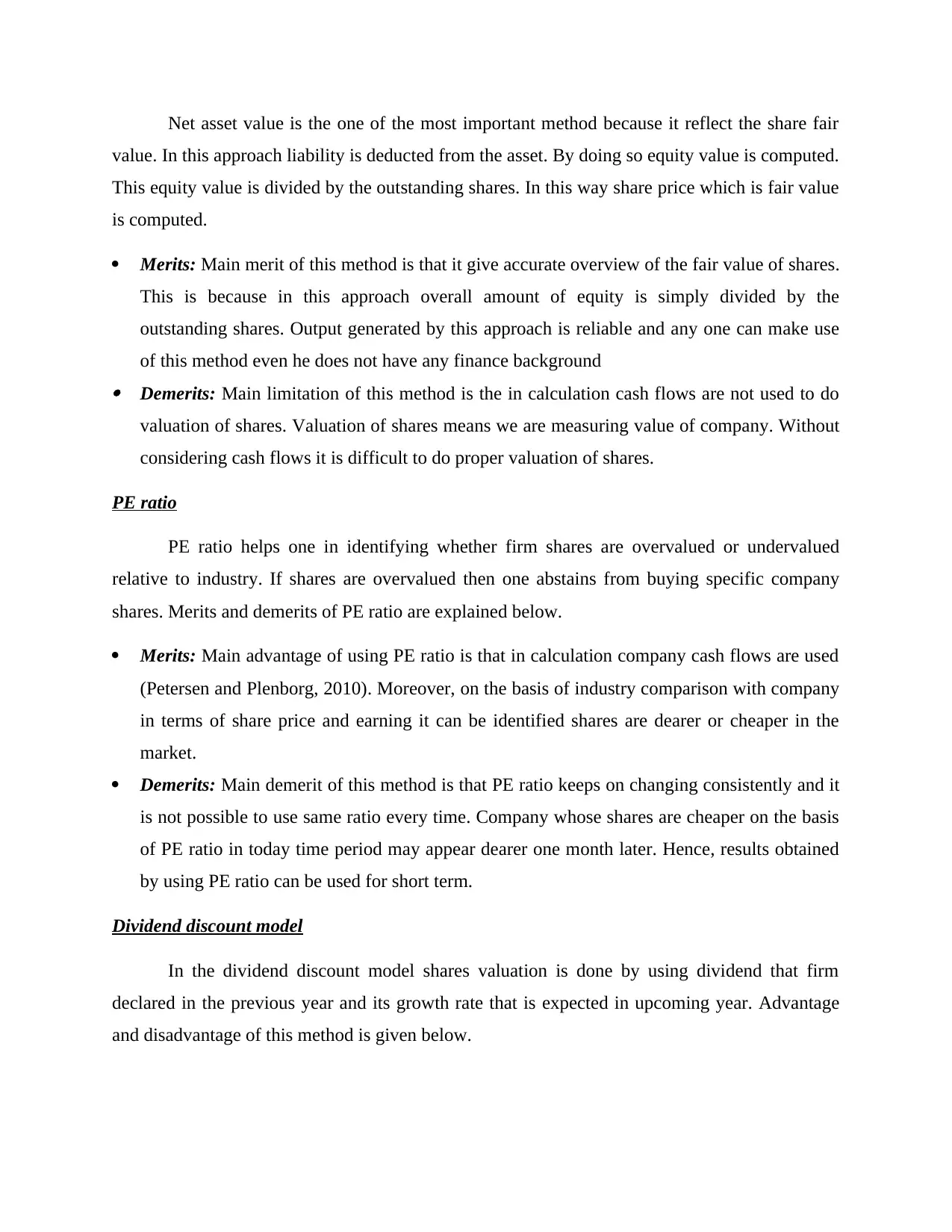
Net asset value is the one of the most important method because it reflect the share fair
value. In this approach liability is deducted from the asset. By doing so equity value is computed.
This equity value is divided by the outstanding shares. In this way share price which is fair value
is computed.
Merits: Main merit of this method is that it give accurate overview of the fair value of shares.
This is because in this approach overall amount of equity is simply divided by the
outstanding shares. Output generated by this approach is reliable and any one can make use
of this method even he does not have any finance background Demerits: Main limitation of this method is the in calculation cash flows are not used to do
valuation of shares. Valuation of shares means we are measuring value of company. Without
considering cash flows it is difficult to do proper valuation of shares.
PE ratio
PE ratio helps one in identifying whether firm shares are overvalued or undervalued
relative to industry. If shares are overvalued then one abstains from buying specific company
shares. Merits and demerits of PE ratio are explained below.
Merits: Main advantage of using PE ratio is that in calculation company cash flows are used
(Petersen and Plenborg, 2010). Moreover, on the basis of industry comparison with company
in terms of share price and earning it can be identified shares are dearer or cheaper in the
market.
Demerits: Main demerit of this method is that PE ratio keeps on changing consistently and it
is not possible to use same ratio every time. Company whose shares are cheaper on the basis
of PE ratio in today time period may appear dearer one month later. Hence, results obtained
by using PE ratio can be used for short term.
Dividend discount model
In the dividend discount model shares valuation is done by using dividend that firm
declared in the previous year and its growth rate that is expected in upcoming year. Advantage
and disadvantage of this method is given below.
value. In this approach liability is deducted from the asset. By doing so equity value is computed.
This equity value is divided by the outstanding shares. In this way share price which is fair value
is computed.
Merits: Main merit of this method is that it give accurate overview of the fair value of shares.
This is because in this approach overall amount of equity is simply divided by the
outstanding shares. Output generated by this approach is reliable and any one can make use
of this method even he does not have any finance background Demerits: Main limitation of this method is the in calculation cash flows are not used to do
valuation of shares. Valuation of shares means we are measuring value of company. Without
considering cash flows it is difficult to do proper valuation of shares.
PE ratio
PE ratio helps one in identifying whether firm shares are overvalued or undervalued
relative to industry. If shares are overvalued then one abstains from buying specific company
shares. Merits and demerits of PE ratio are explained below.
Merits: Main advantage of using PE ratio is that in calculation company cash flows are used
(Petersen and Plenborg, 2010). Moreover, on the basis of industry comparison with company
in terms of share price and earning it can be identified shares are dearer or cheaper in the
market.
Demerits: Main demerit of this method is that PE ratio keeps on changing consistently and it
is not possible to use same ratio every time. Company whose shares are cheaper on the basis
of PE ratio in today time period may appear dearer one month later. Hence, results obtained
by using PE ratio can be used for short term.
Dividend discount model
In the dividend discount model shares valuation is done by using dividend that firm
declared in the previous year and its growth rate that is expected in upcoming year. Advantage
and disadvantage of this method is given below.
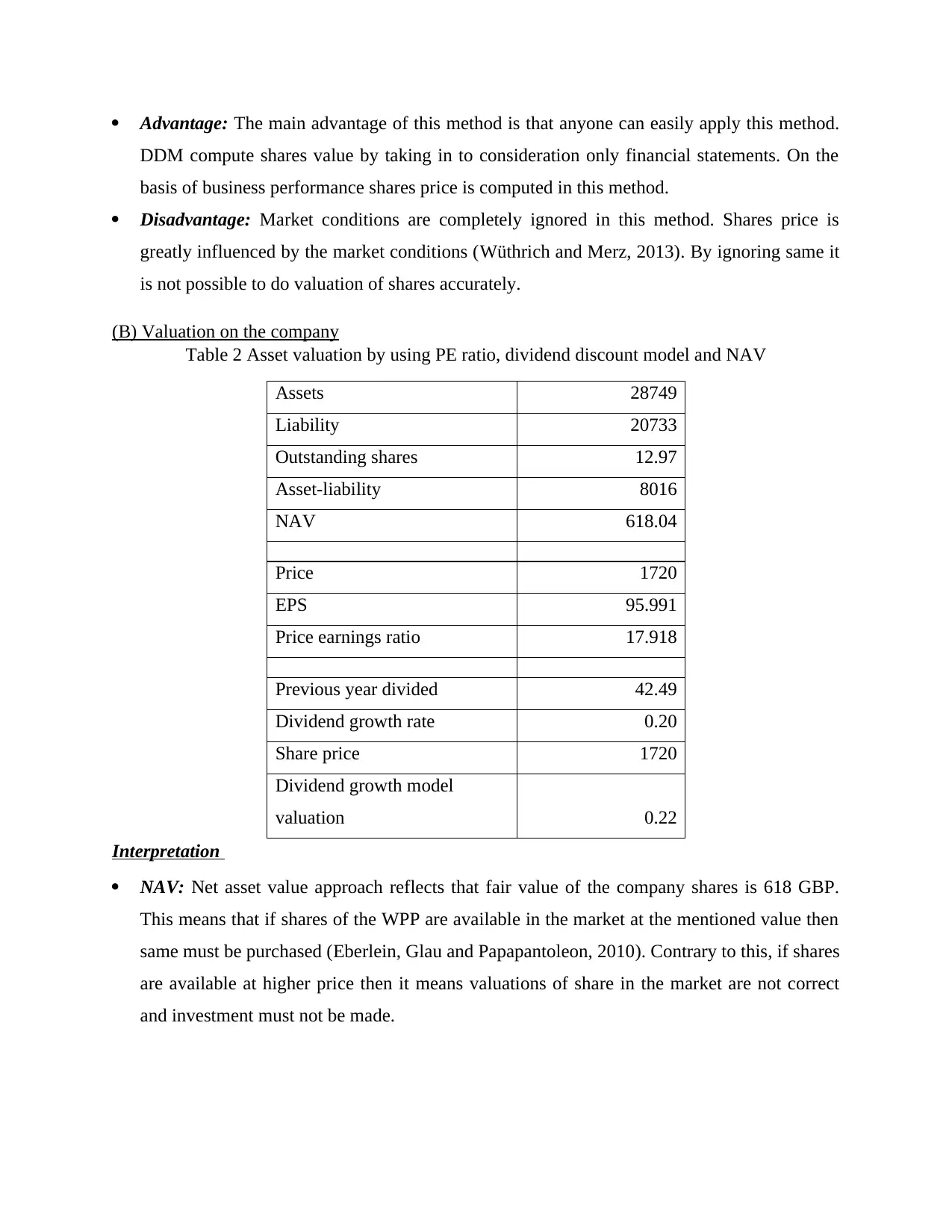
Advantage: The main advantage of this method is that anyone can easily apply this method.
DDM compute shares value by taking in to consideration only financial statements. On the
basis of business performance shares price is computed in this method.
Disadvantage: Market conditions are completely ignored in this method. Shares price is
greatly influenced by the market conditions (Wüthrich and Merz, 2013). By ignoring same it
is not possible to do valuation of shares accurately.
(B) Valuation on the company
Table 2 Asset valuation by using PE ratio, dividend discount model and NAV
Interpretation
NAV: Net asset value approach reflects that fair value of the company shares is 618 GBP.
This means that if shares of the WPP are available in the market at the mentioned value then
same must be purchased (Eberlein, Glau and Papapantoleon, 2010). Contrary to this, if shares
are available at higher price then it means valuations of share in the market are not correct
and investment must not be made.
Assets 28749
Liability 20733
Outstanding shares 12.97
Asset-liability 8016
NAV 618.04
Price 1720
EPS 95.991
Price earnings ratio 17.918
Previous year divided 42.49
Dividend growth rate 0.20
Share price 1720
Dividend growth model
valuation 0.22
DDM compute shares value by taking in to consideration only financial statements. On the
basis of business performance shares price is computed in this method.
Disadvantage: Market conditions are completely ignored in this method. Shares price is
greatly influenced by the market conditions (Wüthrich and Merz, 2013). By ignoring same it
is not possible to do valuation of shares accurately.
(B) Valuation on the company
Table 2 Asset valuation by using PE ratio, dividend discount model and NAV
Interpretation
NAV: Net asset value approach reflects that fair value of the company shares is 618 GBP.
This means that if shares of the WPP are available in the market at the mentioned value then
same must be purchased (Eberlein, Glau and Papapantoleon, 2010). Contrary to this, if shares
are available at higher price then it means valuations of share in the market are not correct
and investment must not be made.
Assets 28749
Liability 20733
Outstanding shares 12.97
Asset-liability 8016
NAV 618.04
Price 1720
EPS 95.991
Price earnings ratio 17.918
Previous year divided 42.49
Dividend growth rate 0.20
Share price 1720
Dividend growth model
valuation 0.22
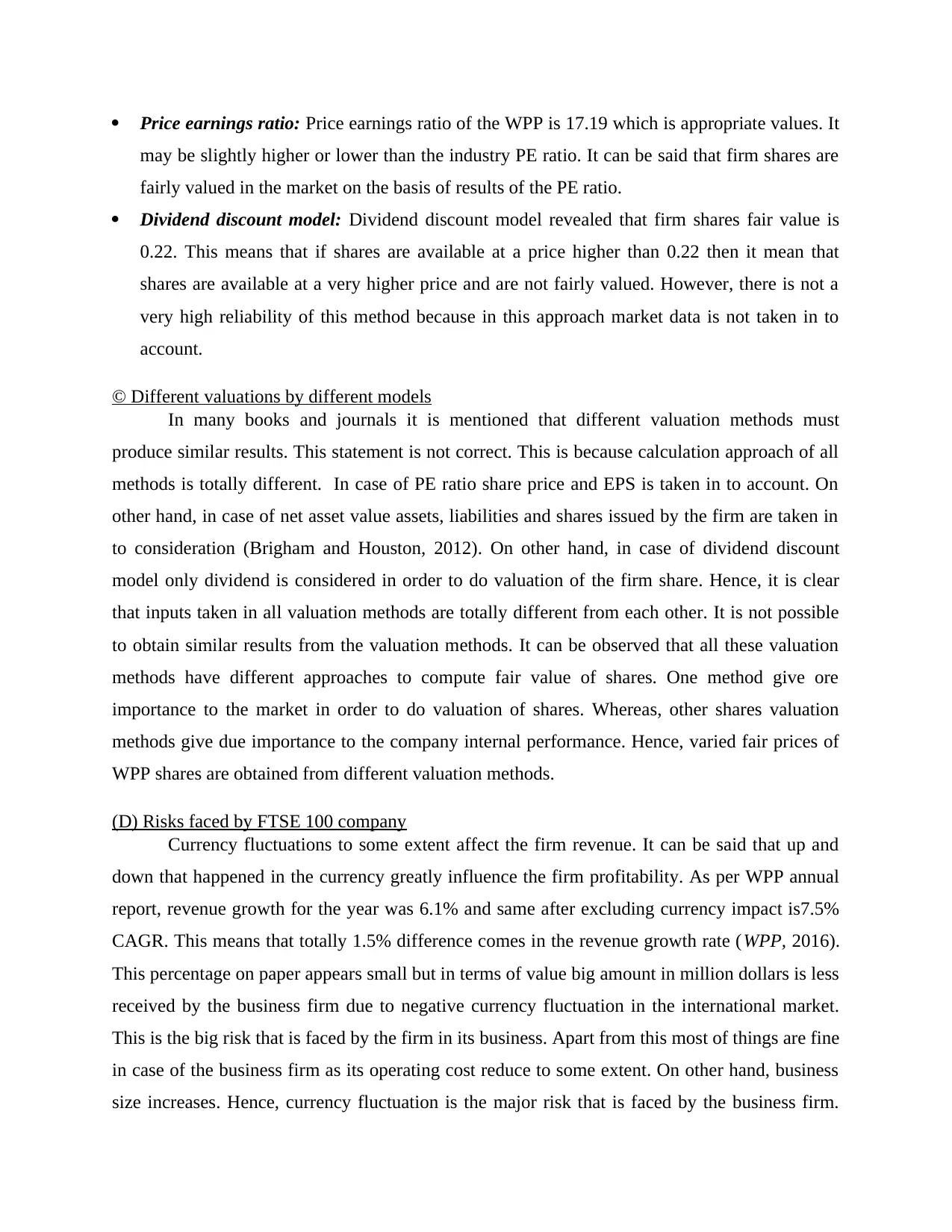
Price earnings ratio: Price earnings ratio of the WPP is 17.19 which is appropriate values. It
may be slightly higher or lower than the industry PE ratio. It can be said that firm shares are
fairly valued in the market on the basis of results of the PE ratio.
Dividend discount model: Dividend discount model revealed that firm shares fair value is
0.22. This means that if shares are available at a price higher than 0.22 then it mean that
shares are available at a very higher price and are not fairly valued. However, there is not a
very high reliability of this method because in this approach market data is not taken in to
account.
© Different valuations by different models
In many books and journals it is mentioned that different valuation methods must
produce similar results. This statement is not correct. This is because calculation approach of all
methods is totally different. In case of PE ratio share price and EPS is taken in to account. On
other hand, in case of net asset value assets, liabilities and shares issued by the firm are taken in
to consideration (Brigham and Houston, 2012). On other hand, in case of dividend discount
model only dividend is considered in order to do valuation of the firm share. Hence, it is clear
that inputs taken in all valuation methods are totally different from each other. It is not possible
to obtain similar results from the valuation methods. It can be observed that all these valuation
methods have different approaches to compute fair value of shares. One method give ore
importance to the market in order to do valuation of shares. Whereas, other shares valuation
methods give due importance to the company internal performance. Hence, varied fair prices of
WPP shares are obtained from different valuation methods.
(D) Risks faced by FTSE 100 company
Currency fluctuations to some extent affect the firm revenue. It can be said that up and
down that happened in the currency greatly influence the firm profitability. As per WPP annual
report, revenue growth for the year was 6.1% and same after excluding currency impact is7.5%
CAGR. This means that totally 1.5% difference comes in the revenue growth rate (WPP, 2016).
This percentage on paper appears small but in terms of value big amount in million dollars is less
received by the business firm due to negative currency fluctuation in the international market.
This is the big risk that is faced by the firm in its business. Apart from this most of things are fine
in case of the business firm as its operating cost reduce to some extent. On other hand, business
size increases. Hence, currency fluctuation is the major risk that is faced by the business firm.
may be slightly higher or lower than the industry PE ratio. It can be said that firm shares are
fairly valued in the market on the basis of results of the PE ratio.
Dividend discount model: Dividend discount model revealed that firm shares fair value is
0.22. This means that if shares are available at a price higher than 0.22 then it mean that
shares are available at a very higher price and are not fairly valued. However, there is not a
very high reliability of this method because in this approach market data is not taken in to
account.
© Different valuations by different models
In many books and journals it is mentioned that different valuation methods must
produce similar results. This statement is not correct. This is because calculation approach of all
methods is totally different. In case of PE ratio share price and EPS is taken in to account. On
other hand, in case of net asset value assets, liabilities and shares issued by the firm are taken in
to consideration (Brigham and Houston, 2012). On other hand, in case of dividend discount
model only dividend is considered in order to do valuation of the firm share. Hence, it is clear
that inputs taken in all valuation methods are totally different from each other. It is not possible
to obtain similar results from the valuation methods. It can be observed that all these valuation
methods have different approaches to compute fair value of shares. One method give ore
importance to the market in order to do valuation of shares. Whereas, other shares valuation
methods give due importance to the company internal performance. Hence, varied fair prices of
WPP shares are obtained from different valuation methods.
(D) Risks faced by FTSE 100 company
Currency fluctuations to some extent affect the firm revenue. It can be said that up and
down that happened in the currency greatly influence the firm profitability. As per WPP annual
report, revenue growth for the year was 6.1% and same after excluding currency impact is7.5%
CAGR. This means that totally 1.5% difference comes in the revenue growth rate (WPP, 2016).
This percentage on paper appears small but in terms of value big amount in million dollars is less
received by the business firm due to negative currency fluctuation in the international market.
This is the big risk that is faced by the firm in its business. Apart from this most of things are fine
in case of the business firm as its operating cost reduce to some extent. On other hand, business
size increases. Hence, currency fluctuation is the major risk that is faced by the business firm.
Paraphrase This Document
Need a fresh take? Get an instant paraphrase of this document with our AI Paraphraser
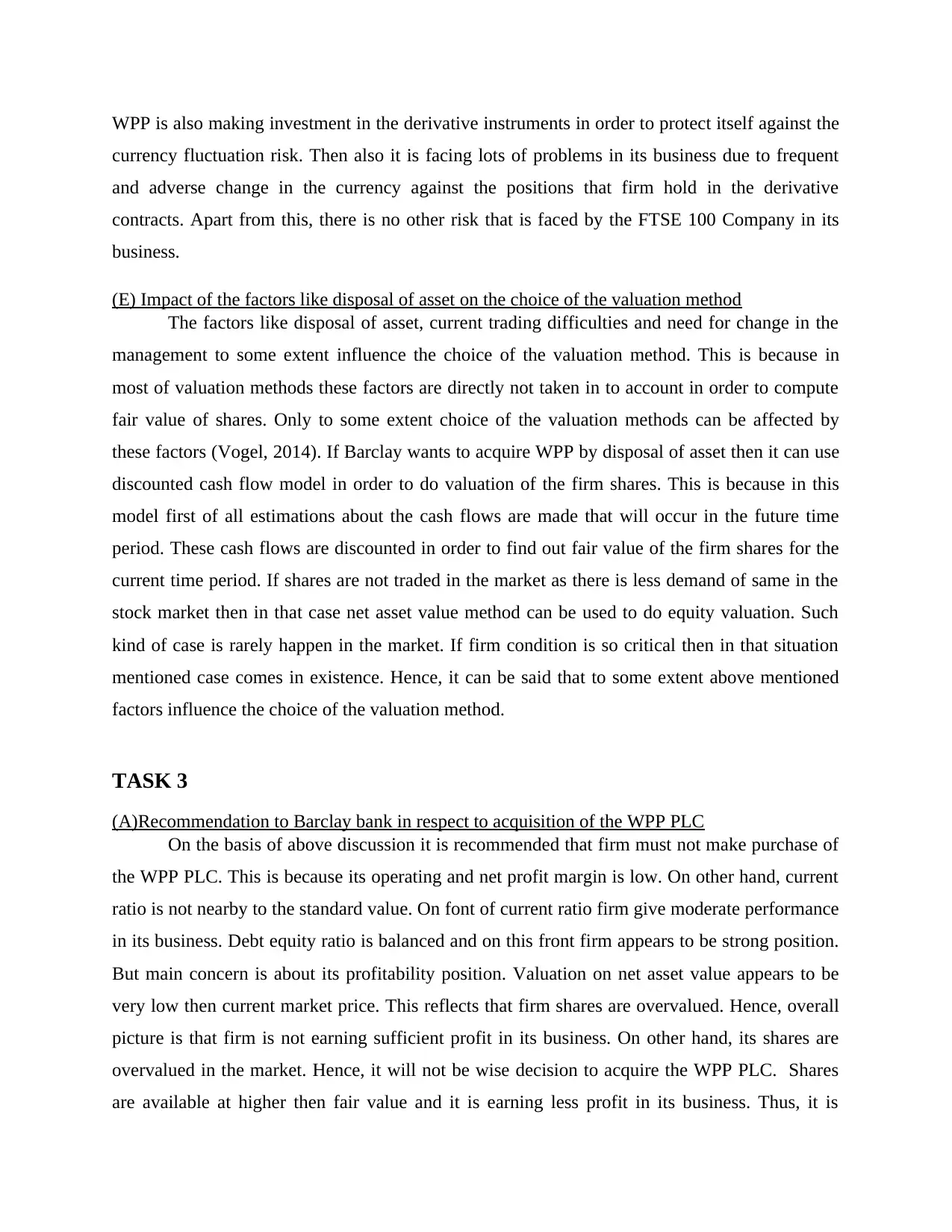
WPP is also making investment in the derivative instruments in order to protect itself against the
currency fluctuation risk. Then also it is facing lots of problems in its business due to frequent
and adverse change in the currency against the positions that firm hold in the derivative
contracts. Apart from this, there is no other risk that is faced by the FTSE 100 Company in its
business.
(E) Impact of the factors like disposal of asset on the choice of the valuation method
The factors like disposal of asset, current trading difficulties and need for change in the
management to some extent influence the choice of the valuation method. This is because in
most of valuation methods these factors are directly not taken in to account in order to compute
fair value of shares. Only to some extent choice of the valuation methods can be affected by
these factors (Vogel, 2014). If Barclay wants to acquire WPP by disposal of asset then it can use
discounted cash flow model in order to do valuation of the firm shares. This is because in this
model first of all estimations about the cash flows are made that will occur in the future time
period. These cash flows are discounted in order to find out fair value of the firm shares for the
current time period. If shares are not traded in the market as there is less demand of same in the
stock market then in that case net asset value method can be used to do equity valuation. Such
kind of case is rarely happen in the market. If firm condition is so critical then in that situation
mentioned case comes in existence. Hence, it can be said that to some extent above mentioned
factors influence the choice of the valuation method.
TASK 3
(A)Recommendation to Barclay bank in respect to acquisition of the WPP PLC
On the basis of above discussion it is recommended that firm must not make purchase of
the WPP PLC. This is because its operating and net profit margin is low. On other hand, current
ratio is not nearby to the standard value. On font of current ratio firm give moderate performance
in its business. Debt equity ratio is balanced and on this front firm appears to be strong position.
But main concern is about its profitability position. Valuation on net asset value appears to be
very low then current market price. This reflects that firm shares are overvalued. Hence, overall
picture is that firm is not earning sufficient profit in its business. On other hand, its shares are
overvalued in the market. Hence, it will not be wise decision to acquire the WPP PLC. Shares
are available at higher then fair value and it is earning less profit in its business. Thus, it is
currency fluctuation risk. Then also it is facing lots of problems in its business due to frequent
and adverse change in the currency against the positions that firm hold in the derivative
contracts. Apart from this, there is no other risk that is faced by the FTSE 100 Company in its
business.
(E) Impact of the factors like disposal of asset on the choice of the valuation method
The factors like disposal of asset, current trading difficulties and need for change in the
management to some extent influence the choice of the valuation method. This is because in
most of valuation methods these factors are directly not taken in to account in order to compute
fair value of shares. Only to some extent choice of the valuation methods can be affected by
these factors (Vogel, 2014). If Barclay wants to acquire WPP by disposal of asset then it can use
discounted cash flow model in order to do valuation of the firm shares. This is because in this
model first of all estimations about the cash flows are made that will occur in the future time
period. These cash flows are discounted in order to find out fair value of the firm shares for the
current time period. If shares are not traded in the market as there is less demand of same in the
stock market then in that case net asset value method can be used to do equity valuation. Such
kind of case is rarely happen in the market. If firm condition is so critical then in that situation
mentioned case comes in existence. Hence, it can be said that to some extent above mentioned
factors influence the choice of the valuation method.
TASK 3
(A)Recommendation to Barclay bank in respect to acquisition of the WPP PLC
On the basis of above discussion it is recommended that firm must not make purchase of
the WPP PLC. This is because its operating and net profit margin is low. On other hand, current
ratio is not nearby to the standard value. On font of current ratio firm give moderate performance
in its business. Debt equity ratio is balanced and on this front firm appears to be strong position.
But main concern is about its profitability position. Valuation on net asset value appears to be
very low then current market price. This reflects that firm shares are overvalued. Hence, overall
picture is that firm is not earning sufficient profit in its business. On other hand, its shares are
overvalued in the market. Hence, it will not be wise decision to acquire the WPP PLC. Shares
are available at higher then fair value and it is earning less profit in its business. Thus, it is

recommended that investment must not be made in WPP PLC. If firm profit margin elevate from
10% to 20% and share price decline to some extent then in that recommendation can be changed.
CONCLUSION
On the basis of above discussion it is concluded that ratio analysis is the one of the most
important tool by using which firm performance is measured in easy way. Managers must make
use of this tool in order to measure firm performance in better way. Apart from this, valuation
methods are very important because same are used to measure firm equity value. Valuation
method must be cautiously used by the managers. This is because all approaches are different
from each other. Hence, according to suitability specific method of valuation must be used by the
business firm.
10% to 20% and share price decline to some extent then in that recommendation can be changed.
CONCLUSION
On the basis of above discussion it is concluded that ratio analysis is the one of the most
important tool by using which firm performance is measured in easy way. Managers must make
use of this tool in order to measure firm performance in better way. Apart from this, valuation
methods are very important because same are used to measure firm equity value. Valuation
method must be cautiously used by the managers. This is because all approaches are different
from each other. Hence, according to suitability specific method of valuation must be used by the
business firm.
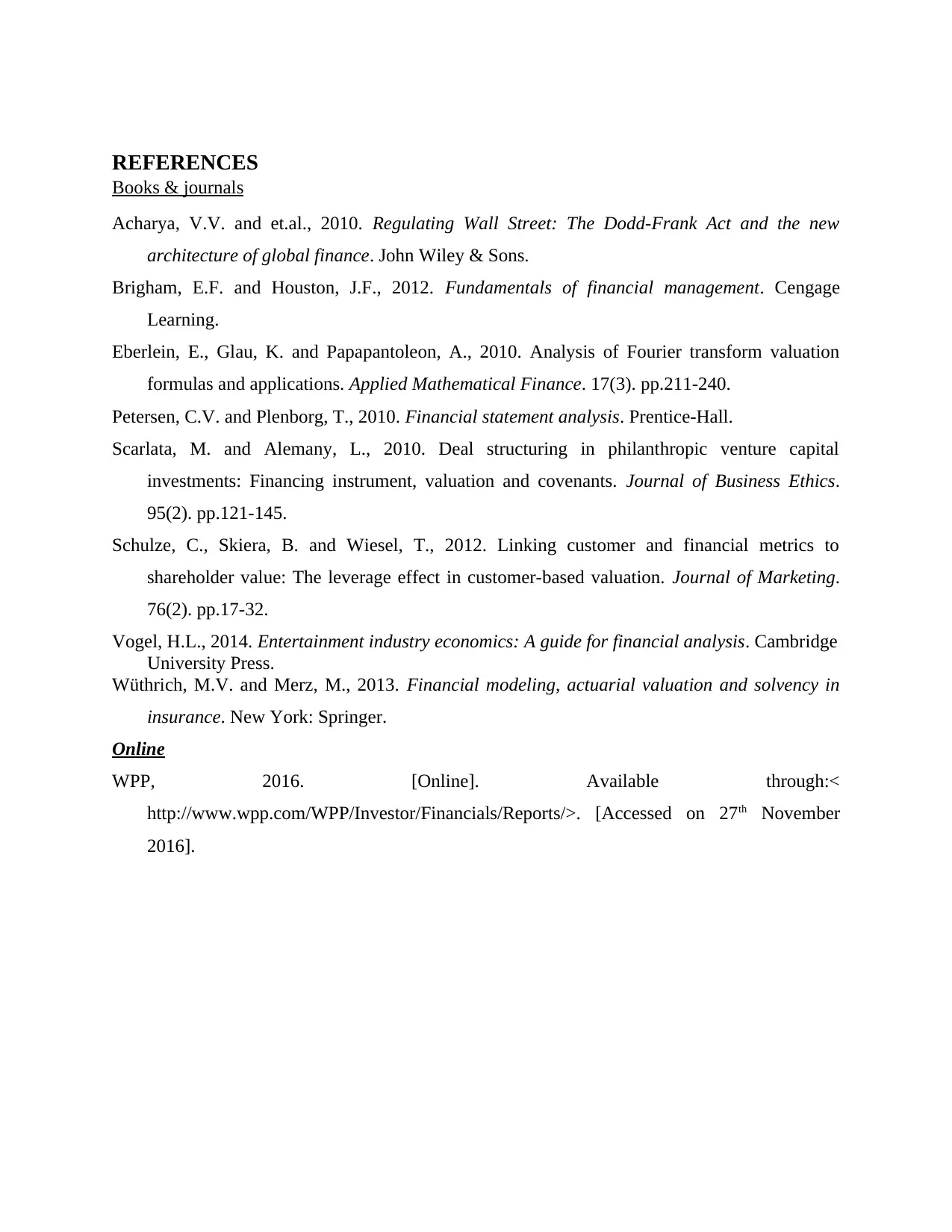
REFERENCES
Books & journals
Acharya, V.V. and et.al., 2010. Regulating Wall Street: The Dodd-Frank Act and the new
architecture of global finance. John Wiley & Sons.
Brigham, E.F. and Houston, J.F., 2012. Fundamentals of financial management. Cengage
Learning.
Eberlein, E., Glau, K. and Papapantoleon, A., 2010. Analysis of Fourier transform valuation
formulas and applications. Applied Mathematical Finance. 17(3). pp.211-240.
Petersen, C.V. and Plenborg, T., 2010. Financial statement analysis. Prentice-Hall.
Scarlata, M. and Alemany, L., 2010. Deal structuring in philanthropic venture capital
investments: Financing instrument, valuation and covenants. Journal of Business Ethics.
95(2). pp.121-145.
Schulze, C., Skiera, B. and Wiesel, T., 2012. Linking customer and financial metrics to
shareholder value: The leverage effect in customer-based valuation. Journal of Marketing.
76(2). pp.17-32.
Vogel, H.L., 2014. Entertainment industry economics: A guide for financial analysis. Cambridge
University Press.
Wüthrich, M.V. and Merz, M., 2013. Financial modeling, actuarial valuation and solvency in
insurance. New York: Springer.
Online
WPP, 2016. [Online]. Available through:<
http://www.wpp.com/WPP/Investor/Financials/Reports/>. [Accessed on 27th November
2016].
Books & journals
Acharya, V.V. and et.al., 2010. Regulating Wall Street: The Dodd-Frank Act and the new
architecture of global finance. John Wiley & Sons.
Brigham, E.F. and Houston, J.F., 2012. Fundamentals of financial management. Cengage
Learning.
Eberlein, E., Glau, K. and Papapantoleon, A., 2010. Analysis of Fourier transform valuation
formulas and applications. Applied Mathematical Finance. 17(3). pp.211-240.
Petersen, C.V. and Plenborg, T., 2010. Financial statement analysis. Prentice-Hall.
Scarlata, M. and Alemany, L., 2010. Deal structuring in philanthropic venture capital
investments: Financing instrument, valuation and covenants. Journal of Business Ethics.
95(2). pp.121-145.
Schulze, C., Skiera, B. and Wiesel, T., 2012. Linking customer and financial metrics to
shareholder value: The leverage effect in customer-based valuation. Journal of Marketing.
76(2). pp.17-32.
Vogel, H.L., 2014. Entertainment industry economics: A guide for financial analysis. Cambridge
University Press.
Wüthrich, M.V. and Merz, M., 2013. Financial modeling, actuarial valuation and solvency in
insurance. New York: Springer.
Online
WPP, 2016. [Online]. Available through:<
http://www.wpp.com/WPP/Investor/Financials/Reports/>. [Accessed on 27th November
2016].
1 out of 10
Related Documents
Your All-in-One AI-Powered Toolkit for Academic Success.
+13062052269
info@desklib.com
Available 24*7 on WhatsApp / Email
![[object Object]](/_next/static/media/star-bottom.7253800d.svg)
Unlock your academic potential
© 2024 | Zucol Services PVT LTD | All rights reserved.





